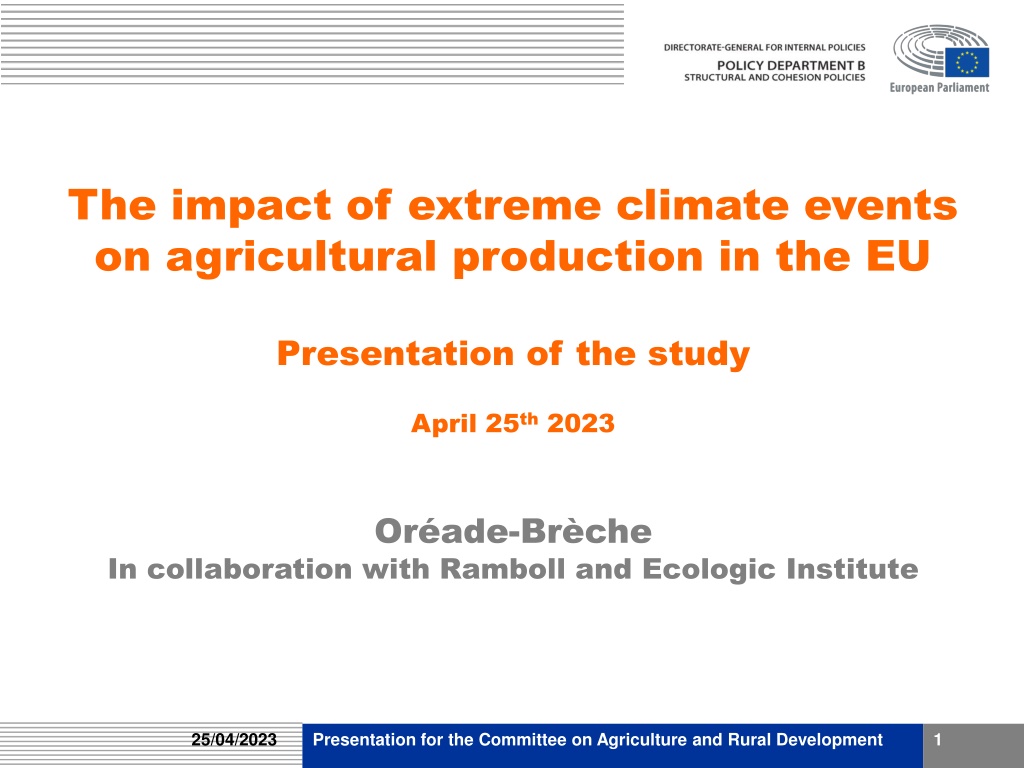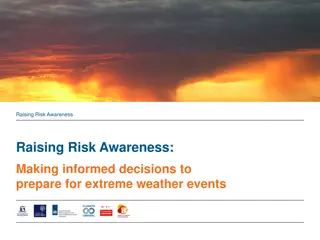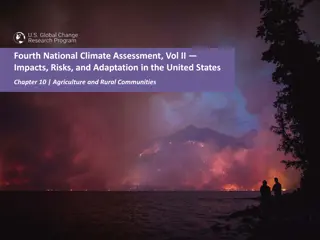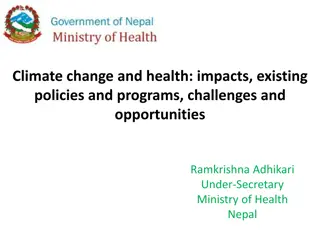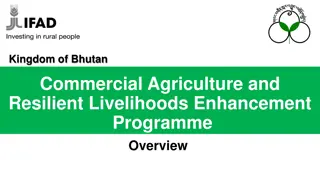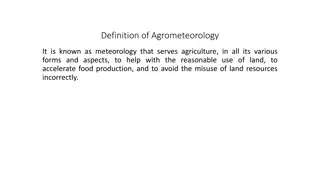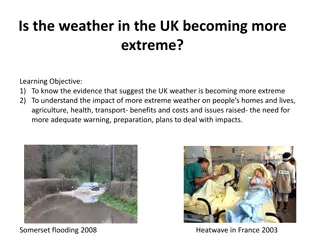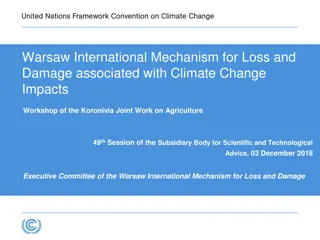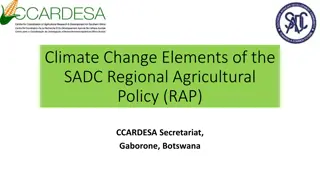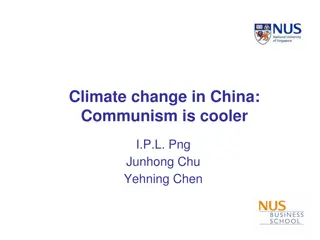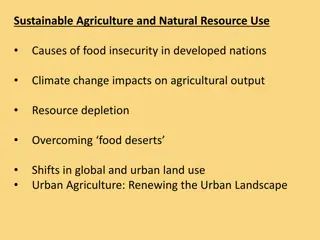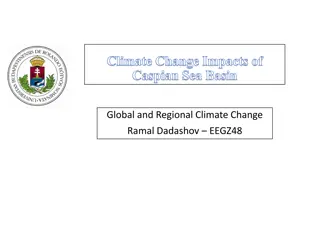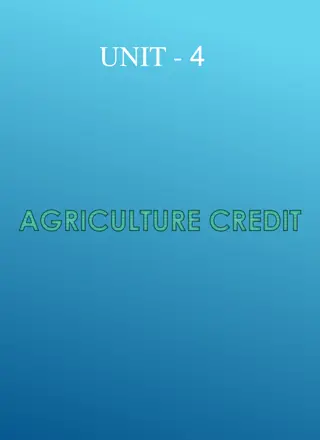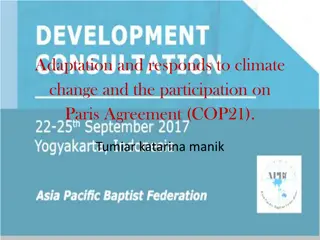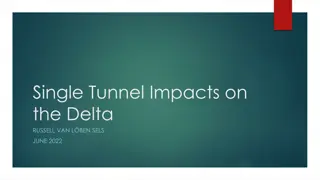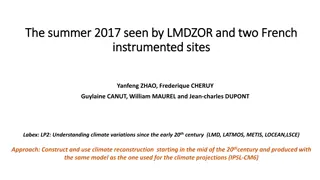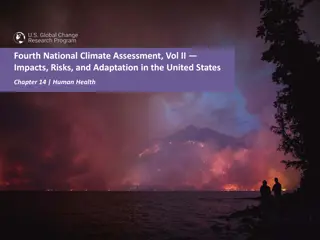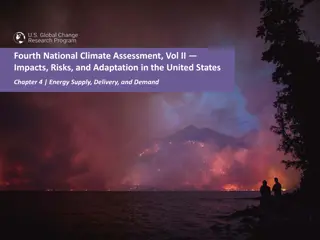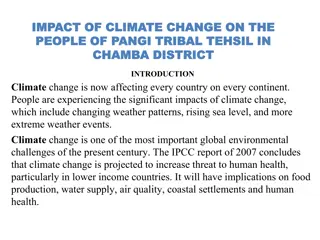Impacts of Extreme Climate Events on EU Agricultural Production
The study discusses the impacts of extreme weather events on the agricultural sector in the EU, highlighting regional vulnerabilities and projected economic losses due to drought and heat. It also explores existing solutions, policy instruments, and adaptation options to mitigate these effects. With increasing climate extremes, the agricultural sector faces challenges that require urgent attention and proactive measures.
Download Presentation

Please find below an Image/Link to download the presentation.
The content on the website is provided AS IS for your information and personal use only. It may not be sold, licensed, or shared on other websites without obtaining consent from the author. Download presentation by click this link. If you encounter any issues during the download, it is possible that the publisher has removed the file from their server.
E N D
Presentation Transcript
The impact of extreme climate events on agricultural production in the EU Presentation of the study April 25th2023 Or ade-Br che In collaboration with Ramboll and Ecologic Institute 25/04/2023 Presentation for the Committee on Agriculture and Rural Development 1
Objectives and scope of the study Description of the impacts of extreme weather events on the EU agricultural sector 1. Review of the existing solutions for the agricultural sector to better prevent, cope with and recover from adverse climate events 2. Analysis of existing EU policy instruments supporting the agricultural sector in the light of climate change, including CAP strategic plans implemented by Member States 3. Best practice examples on how to further contain the adverse effects of climate change for agriculture 4. 25/04/2023 Presentation for the Committee on Agriculture and Rural Development 2
Climate extreme events are increasing in the European Union Pronounced regional differences : Northern Europe and mountainous regions: increase in heavy rainfall. Southern Europe : increase in severe drought and extreme temperatures (heatwaves). Western and Central Europe: increase in heat extremes and in heavy precipitation. 25/04/2023 Presentation for the Committee on Agriculture and Rural Development 3
Vulnerability of the agricultural sector to climate extreme events Crops highly vulnerable to : Heat stress and drought : maize, fruit trees, soybean, grassland. Flooding : tuber crops. Soil management practices, crops selection and water management are major factors influencing crops vulnerability to extreme weather events. 25/04/2023 Presentation for the Committee on Agriculture and Rural Development 4
Impacts of climate extreme events on the agricultural sector will increase Especially due to the expected increase in drought and heat Yield losses that translate into economic losses Drought and heat Extreme weather events that have caused, in the past, the greatest negative economic impacts on European agriculture Economic losses due to drought are expected to increase in the future Cost of drought by 2100 under pessimistic scenarios could reach : 28.6 billion annually Cost of drought in 2015 : 4.8 billion 25/04/2023 Presentation for the Committee on Agriculture and Rural Development 5
Adaptation options exist at different levels Adaptation options Potentially supported by At farm level: Crop rotation, adapted species/varieties, production diversification, prevention investments (e.g., sustainable irrigation systems, hail protection, etc.) Subsidised prevention investment, subsidised insurance and mutual funds, advisory, training and awareness services, EU direct payments, CAP market measures, etc. Ex-ante public support (EU/MS) prepardness (pre-event) Prevention and At sector level: Climate change observatories and early warning systems (post-event) CAP exceptional measures, other EU funds, ad-hoc aid. Ex-post public support (EU/MS) Recovery Market tools: Private instruments (insurance) or mutual funds, etc. 25/04/2023 Presentation for the Committee on Agriculture and Rural Development 6
Existing EU policy instruments supporting adaptation of the agricultural sector Large number of EU strategies and policies developed in recent years. No European directive or regulation specifically dedicated to drought management. Synergies between water management, agricultural and climate policies still limited. Sector Policies at EU level EU Water Framework Directive - 2000 Groundwater Directive - 2006 Water Floods Directive - 2007 European Water Scarcity and Droughts Policy - 2012 European Climate Law Regulation - 2019 Climate EU Adaptation Strategy - 2021 Land use LULUCF Regulation for 2021-2030 EU Nature Restoration Law - 2022 EU Biodiversity Strategy for 2030 - 2020 Biodiversity and food Farm to Fork Strategy - 2020 EU Soil Strategy for 2030 - 2021 Agriculture Common Agricultural Policy (CAP) 2023-2027 25/04/2023 Presentation for the Committee on Agriculture and Rural Development 7
The CAP remains the main policy to support adaptation solutions in MS CAP = essential lever for putting EU strategies and policy initiatives into action and contributes to the European Green Deal Minimum practices beneficial for climate adaptation are mandatory (e.g., maintenance of permanent grassland, protection of wetlands and peatlands, etc.) Conditionality Greening payments replaced by eco-schemes (to strengthen the CAP environmental and climate dimension) At least 25% of the budget for direct payments must be dedicated to eco-schemes. Direct payments Rural At least 35% of EAFRD to be allocated to interventions supporting climate, biodiversity, environment and animal welfare (i.e., ENVCLIM interventions) development interventions Greater flexibility granted to the Member States, within their CSP. 25/04/2023 Presentation for the Committee on Agriculture and Rural Development 8
MS choices to address climate change adaptation objectives within their CSPs Member States identified more needs related to mitigation than adaptation Instruments implemented by MS to foster climate change adaptation : mainly eco-schemes, sectoral interventions, ENVCLIM interventions and Invest interventions Risk management tools not seen as instruments that specifically address climate change adaptation needs. 25/04/2023 Presentation for the Committee on Agriculture and Rural Development 9
Adaptation solutions supported by MS through their CSPs Prevention of flood damage : rotations, plant cover and limiting tillage (favorable to soil structure), maintenance or establishment of hedges or buffer zones. Prevention of droughts: efficient use of irrigation water, increase water retention in soils, crop rotation, crop diversification and adoption of more drought and heat tolerant species. Other extreme weather events (hail, storms) are less targeted by specific interventions. Support for recovery after an extreme event is less promoted (e.g., subsidized insurance and mutual funds). 25/04/2023 Presentation for the Committee on Agriculture and Rural Development 10
Recommendation 1: Promote more systemic approaches Key findings MS promote in their CSPs a wide range of interventions that generally support single practices Effective articulation and complementarity between these interventions seems to be lacking. Ex. of the Dutch eco-scheme, designed according to a points-based system Revise interventions mechanisms to promote more holistic approaches (e.g., eco-schemes based on a point- based, result-oriented, or system-based approach). RECO 1 25/04/2023 Presentation for the Committee on Agriculture and Rural Development 11
Recommendation 2: Better support the deployment of risk management tools Key findings A relatively weak mobilization of the CAP to support the deployment of risk management tools (insurance, mutual funds). Support general uptake by farmers of risk management tools (e.g., subsidized insurance and mutual funds) Ex. of the Spanish Combined Agricultural Insurance System (SSAC) Ex. of the new French insurance system based on the National Solidarity Fund RECO 2 25/04/2023 Presentation for the Committee on Agriculture and Rural Development 12
Recommendation 3: Assess the contribution of the CAP Key findings While some interventions appear ambitious, their effective contribution will depend on the uptake by farmers Adaptation objectives set by MS remain too generic without any mention to climate extreme events Analyse in the coming years which CAP instruments / adaptation solutions were effectively implemented Assess the ability of the Performance Monitoring and Evaluation Framework to report on the contributions of each CSP RECO 3 25/04/2023 Presentation for the Committee on Agriculture and Rural Development 13
Recommendation 4: Strengthen synergies between EU policies Key findings A lack of articulation between the CAP and the Water Framework Directive at river basin level, limiting ambitious measures on water management for the agricultural sector under climate extreme events Strengthen synergies between water management , agricultural and climate policies, through a better integration of flood risk and drought risk management into CSP Ex. of the Area- Specific Disadvantages (ASD) intervention in the autonomous community of Aragon in Spain RECO 4 25/04/2023 Presentation for the Committee on Agriculture and Rural Development 14
Questions session For more references / information : Alice DEVOT: a.devot@oreade-breche.fr Lucie ROYER: l.royer@oreade-br che.fr Link to the report: https://research4commi ttees.blog/category/agri /agri-publications/ 25/04/2023 Presentation for the Committee on Agriculture and Rural Development 15
